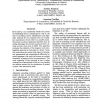Free Online Productivity Tools
i2Speak
i2Symbol
i2OCR
iTex2Img
iWeb2Print
iWeb2Shot
i2Type
iPdf2Split
iPdf2Merge
i2Bopomofo
i2Arabic
i2Style
i2Image
i2PDF
iLatex2Rtf
Sci2ools
ACL
1998
1998
Bitext Correspondences through Rich Mark-up
Rich mark-up can considerably benefit the process of establishing bitext correspondences, that is, the task of providing correct identification and alignment methods for text segments that are translation equivalences of each other in a parallel corpus. We present a sentence alignment algorithm that, by taking advantage of previously annotated texts, obtains accuracy rates close to 100%. The algorithm evaluates the similarity of the linguistic and extralinguistic mark-up in both sides of a bitext. Given that annotations are neutral with respect to typological, grammatical and orthographical differences between languages, rich mark-up becomes an optimal foundation to support bitext correspondences. The main originality of this approach is that it makes maximal use of annotations, which is a very sensible and efficient method for the exploitation of parallel corpora when annotations exist.
| Added | 01 Nov 2010 |
| Updated | 01 Nov 2010 |
| Type | Conference |
| Year | 1998 |
| Where | ACL |
| Authors | Raquel Martínez, Joseba Abaitua, Arantza Casillas |
Comments (0)

